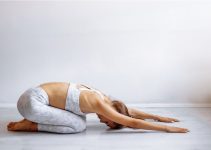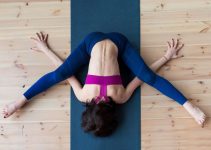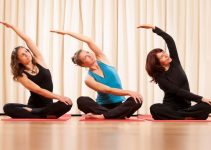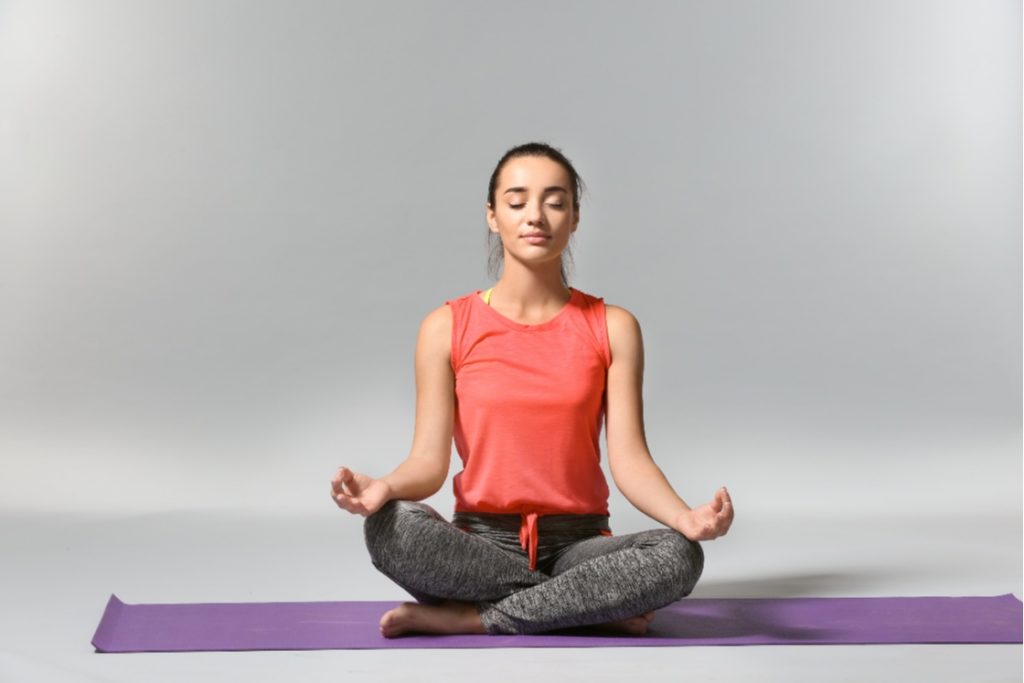
| Sanskrit | Sukhasana |
| Pronunciation | Soo-kaah-SUN-ah |
| Common | Decent pose, Easy pose, Pleasant pose |
| Type | Seated |
| Level | Beginner |
| Stretches | Hips, Groin, Knee, Ankle, Outer thighs, Arms |
| Strengthens | Back, Shoulders, Chest, Spine, Lower Back |
The easy pose, known as Sukhasana in Sanskrit, is one of the basic and beginner postures in yoga. The word Sukh means easy, comfortable, joyful, happy, which is aptly reflected in the pose. Here, “easy” does not mean that it is easy to perform, but that the pose can be performed with ease. It is a relaxing and restorative pose that rejuvenates the mind and body.
Practicing the easy pose is extremely beneficial for stiff hips and to improve flexibility. When people sit in a chair for extremely long periods of time, the hips do not get enough movement and the stretch they need. The stress of a busy lifestyle can also affect the hips. Easy Pose helps open the pelvis, rotate the hip joints outward and also stretch the thigh muscles.
Easy Pose is one of the simplest poses and is suitable for all beginners and advanced practitioners. It opens the hips and stretches the spine. In addition, this asana keeps us grounded and calm.
It is also a milder variation of the lotus pose, or Padmasana and can also be used as a warm up pose for it. Due to this reason, it is often used for meditation and pranayama practice.
Sitting cross legged will also help you straighten your back, strengthen your knees and ankles and improve your posture.
In this article, we will look at the steps to perform the easy pose along with some tips to remember, precautions to be taken care of and benefits of practicing this pose.
Practice Guide for Easy Pose (Sukhasana)
Preparatory Pose
- Staff Pose (Dandasana)
- Accomplished Pose (Siddhasana)
How to Do Easy Pose(Steps)
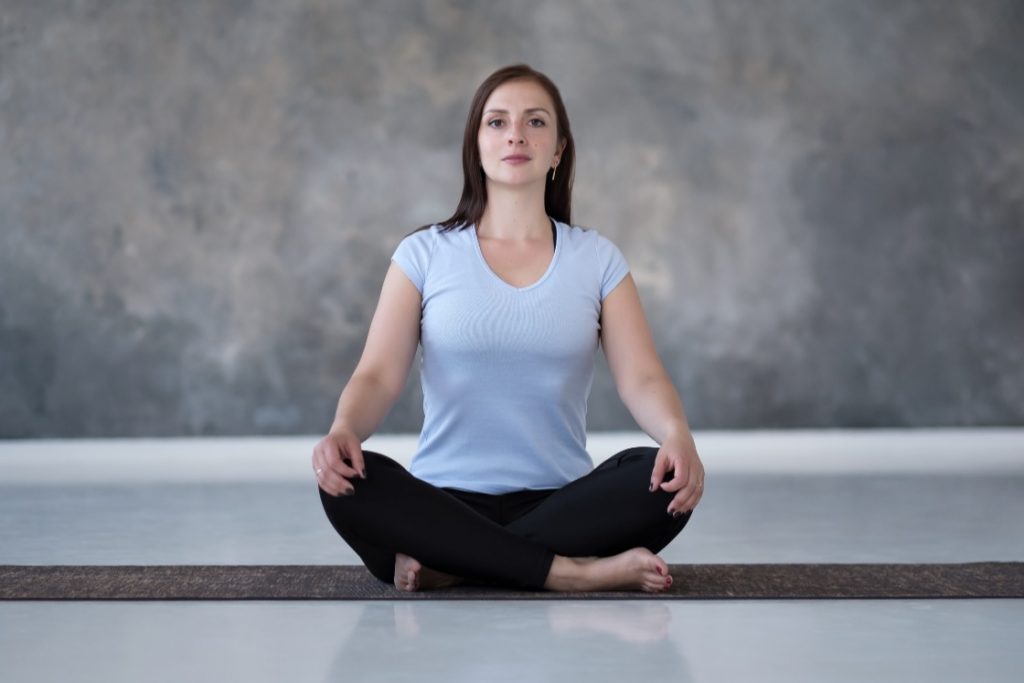
- Sit on a yoga mat and stretch your legs out in front of you, the Dandasana position. Make sure your spine and head are straight.
- If your hips are tight, you can sit on a yoga block, cushion or bolster.
- Bend the knee by rotating the hips outward, and bring each foot under the opposite knee. The inside edge of the foot is under the knee, and the outside edge should be touching the mat.
- Keep a comfortable distance between the lower legs and the pelvis.
- To keep your back straight, push your shoulder blades back and puff out your chest slightly. Imagine that you are stretching the crown of your head upward and grounding your hip bones toward the floor.
- Place your hand on your knees or lap in a Hasta Mudra of your choice, palms facing up.
- Your head should be relaxed, chin tilted slightly inward to bring it in line with your spine. Choose a focal point to keep your gaze straight. If you wish, you can also close your eyes.
- Relax and stay in this posture for 7-10 breaths. Keep alternating between the legs
Tips to remember
Practitioners often unconsciously tend to round their backs. To maintain a straight spine, imagine a thread pulling you up from the crown of your head. A support under the buttocks is also helpful.
- Pulling your abdominal muscles toward your lower spine can also help you maintain a straight back.
- Brace yourself against the wall if you are a beginner and cannot keep your spine straight.
- Pull your shoulder blades back and down to avoid slouching and a compressed neck.
- Do not pull your legs in too far, as this can cause excessive stress on the knee.
- Use aids such as rolled blankets/towels or yoga blocks under the knees to cushion and support them.
- If you feel too much pressure on the ankles, also place a folded blanket or towel under the ankles.
Precautions and Contraindication
- if you have back pain, you should not perform this asana for more than 5-7 minutes.
- Avoid this asana if you have had a recent injury or surgery to your legs, hips or back.
- Do not perform this asana if you have arthritis in your knees, inflammation in your back, or other spinal problems.
- People suffering from sciatica should not perform the asana as it can pinch the sciatic nerve and aggravate the problem.
- People suffering from anxiety or migraines should not close their eyes when practicing this pose.
Variations and Modifications
- If you cannot sit on the floor for longer durations, use a chair, without an armrest, to practice this pose. Sit on the chair, with you back straight and feet firmly grounded on the floor. Bring one foot up and place it on the opposite knee. You can hold the ankle and knee of the bent leg to keep it in place.
- For more support to the spine and improving the alignment, sit with your back to the wall and place a yoga block between the lower shoulder blade and the wall.
- For beginners, to gradually get into the pose, keep one leg stretched out while you can bring the other foot under the knee. Place a blanket under the knee and ankle of the bend leg for better alignment and padding. A prop can also be placed under the heel of the straight leg to release some pressure from the knee and thighs.
Follow-Up Poses
Butterfly Pose (Badhakonasana)
Firelog Pose (Agnistambhasana)
Benefits of Easy Pose (Sukhasana)
The easy pose is extremely beneficial to open your hips and increase its range of mobility. It will also help you improve your posture, lengthen the spine, strengthen your knees and ankles, and stretch the thigh muscles as well. Below are some common benefits you can achieve if you regularly practice easy pose.
- The easy pose increases postural awareness and uses the back muscles to maintain a straight back.
- A straight back improves the alignment of the spine and increases its flexibility.
- It opens the hips by externally rotating the hip joints and increases the range of motion. This helps reduce tightness from the hip muscles and release accumulated stress.
- By pulling in the abdominal muscles, you can strengthen your core and improve the functioning of the digestive system.
- Apart from the hips, it also stretches and opens the groin and inner thighs.
- Sitting in an easy pose can help alleviate mild knee and lower back pain, especially for pregnant women.
- Bending the knees can help in releasing tightness that is a result of sitting for long hours thus improving mobility
- It also aids in the relaxation of tense shoulders as well as the broadening of the chest and collar bones.
- It is a relaxing pose which can activate the parasympathetic nervous system (PNS) which in turn can regulate blood pressure.
- It improves concentration by calming the mind. It helps remove negative emotions such as anxiety, fear, sadness, frustration, stress, tension, etc.
- A calm and relaxed mind can help mitigate mild symptoms of depression.
- Using it as a meditative pose, it can help the prana travel through the spine, balancing and activating all the chakras.
- It aids in promoting peacefulness and serenity, which in turn helps in looking inwards and enhances self awareness.
Conclusion
The easy pose is a simple and basic pose that can be practiced at any time. It consists of sitting in any comfortable position. Try lying on the floor and sitting in silence whenever you seek solace. This asana has numerous benefits on its own, which can be enhanced by combining it with other asanas.
